I’ve written on this subject before, but stick with me because I think it bares repeating from time to time.
I was one of those really bald babies. I mean, I was so bald that if my mom put me in a pink, ruffly dress and taped a bow to my head, strangers would still ask my gender. No kidding. True story. Ask my mother if you don’t believe me.
I finally started growing hair around two years old. It was the blonde fluff you see on newborns and toddlers and it kinda upped my little boy status as far as looks go. At around three or four years old my mom began to notice bald patches on my scalp. I was taken to a doctor and was diagnosed with Alopecia Areata. This is an auto-immune disorder in which my immune system confuses hair follicles with diseases and spends most of it’s quality time attacking the deadest thing that my body can produce. At the time of my diagnosis, there was very little known about my disorder. So little, in fact, that it wasn’t even categorized as an auto-immune disorder. It was kind of understood that I was just one of those special people that couldn’t grow hair properly. There also weren’t a lot of treatments available at that time. The best known treatment was to stimulate the scalp through some form of irritation in order to encourage hair growth. The most successful treatment was steroids injections, but my mother wasn’t about to subject her four-year old that sort of pain. Instead, my parents decided on using the sun. Yes, the sun. I know that sounds weird but exposing the bald portions of my scalp to sunlight (real or artificial) until the skin burned was the cheapest and kindest form of treatment available to me. And because this treatment began when I was very young, I found it normal because it was all I had ever known.
As I got older, I started to realize that “baldy spots” were abnormal. My first eye-opening moment happened during a church baseball game. I was playing with a new friend on a nearby hill of sand. As I bent forward to construct a new tower for my sand castle, my hair shifted and exposed one of my spots.
“What is that?!” asked my new friend, pointing at the spot.
“It’s my baldy spot,” I replied calmly.
“What’s a baldy spot?” she asked.
“It’s a spot where I have no hair,” I answered.
“Is that the only one?”
“No,” I replied, “I have more.”
“I don’t have baldy spots,” she declared.
“But everyone has baldy spots,” I argued.
“I don’t know anyone who has baldy spots,” she stated.
It was then that I realized I was the only person in my family that was sitting out in the sun hoping to get burned on a daily basis, and that other than my father’s receding hairline, I really didn’t know anyone else who had bald spots. Now I knew that I was not normal. And there was no going back.
Before I continue, it’s important to note a few things about Alopecia:
- Alopecia is a fancy word that means bald. It sounds complicated but it’s just a pretty way to say I have no hair.
- Alopecia is not hereditary. There are a small percentage of people who have Alopecia and there is no way to trace it through blood lines. It seems to be a genetic lottery that I have won. Some people have it, most people don’t.
- Hormone changes and changes in stress level can impact the severity of your condition.
- There are varying stages of Alopecia:
- Alopecia Aereta: losing portions or clumps of hair, leaving bald spots on the scalp or other body parts
- Alopecia Totalis: losing drastic portions of hair. Most people who have this have completely bald scalps.
- Alopecia Universalis: complete hair loss, including eyebrows, eyelashes, and all body hair.
Now, because Alopecia is not genetic and is quite varied between people and circumstances, it was not termed an auto-immune disorder for quite a while.
And while doctors were exploring the world of Alopecia, I was learning to live with it. Now that I knew it wasn’t normal, I recognized it as something I needed to hide. My mother did my hair well into my teen years because the spots would come and go and covering them up with the hair I had could be tricky. For a long time, my hair was kept short so that the length wouldn’t put too much weight on my head. That sounds weird, I know, but that’s what doctors suggested. But I didn’t feel like much of a girl with short hair. So I was allowed to grow my hair longer, but I had to have perms. There was hope that the chemicals from perming would irritate my scalp the way my sun lamp did.
My parents were very diligent. We tried everything the doctors suggested. I used tars and salves. I combined them with my head burning routine.
But as I grew older, the hair loss only seemed to get worse. I know now that it had a lot to do with the stress of my school environment (I did not have a good school experience) and my changing hormones. But at the time, I believed it was my fault for not working harder at making my hair grow.
How insane does that sound? I was blaming myself for not willing my hair to grow.
Weirdly, I had one year where I had a full head of hair: My senior year of High School. I think I was so relieved to be graduating the my body relaxed and started behaving as a body should. But that’s just a theory.
Once I was in college, the hair loss worsened. In desperation, I began steroid treatments. I would travel to Atlanta once a month and see a specialist that would stab my scalp with needles until each bald spot was covered with injections. It was insanely painful. And although I saw some growth, I was forced to stop when my skull began to deteriorate. You read that right: DETERIORATE. I had begun to develop pot holes in my scalp from the treatments. Sure, I wanted hair but not as much as I wanted a skull to protect my brain.
I resigned myself to a life of hair loss. But secretly, I still blamed myself for my inability to be normal.
After having my daughter, I had almost completely lost all of my hair. My husband finally encouraged me to give up on my hair and buy a wig. It was a hard experience. I was admitting defeat. I was giving up. I also had to look at myself. I had to take an honest look in the mirror and deal with the person that was staring back at me. I was alien. I was sick. And I found myself hideous and scary.
Getting acclimated to life without hair was a struggle. I was embarrassed for anyone to see me without the wig. I wouldn’t go swimming because we couldn’t afford a swim wig. I didn’t like unexpected company coming over because I didn’t want to get caught off guard. It took me a month before I would allow my family to see me without a wig and even then, I tried to keep the bald parading to bed times. I was jumpy.
It only took a year for the wigs to become uncomfortable. They itched, they were heavy, and in the summer it was like wearing a fur hat. They caused me to get dehydrated quickly. I stayed home a lot because I could be bald at home without judgment, and there was the added bonus of comfort.
Then, one day, what I feared most happened. Our babysitter showed up half an hour early and caught me running across the house without any hair. I didn’t want to talk to her about it, but I knew she had seen me. The next day, at church, her mother pulled me aside and told me that my disorder was nothing to be ashamed of. Her words spoke volumes to me, “It’s so much easier to be the person God made you than to try to hide the flaws.”
Lightbulb moment.
I began being more honest. When people would compliment my hair, I would say, “Thanks. It’s not mine.” I went swimming with the kids. If someone showed up on my doorstep unannounced, they had to deal with the shock of seeing me wigless. If I was too hot, the wig came off. No need to go to the hospital over vanity. I even began working out without the wig. Step-by-step, I was starting to change my outlook. I wasn’t abnormal. I was a unique creation. There was a purpose behind my suffering (although, really, I didn’t suffer that much). Still, I wasn’t ready to go completely wigless. I feared the stares and the questions that would come along with traipsing about without hair.
At the end of summer, 2013, me and the kids took a trip out to the bank. It was a really hot day, so I had taken my wig off in the car. After parking, I decided that it was far too hot for me to don the wig and began to exit.
“Wait, Mommy!” my daughter shouted from the backseat, “you forgot your hair!”
“It’s too hot to wear my hair, baby,” I explained.
She pushed the wig into my hands and said the saddest sentence I’ve ever heard her utter, “but if you don’t wear your hair, people won’t love you.”
What had I done? While I was fighting my inner demons, my daughter had been watching. And the message she heard was that my differences made me unloveable. She saw my shame and interpreted it as hatred. I wasn’t ashamed of the person God had made me, but I was scared of judgement from others. I didn’t want to go back to that sand pile and answer questions again. And while I was hiding in the shadows, my daughter was taking notes.
I couldn’t allow this to continue.
I placed my wig on the passenger seat next to me, and helped my children out of the car. Chrissy was still worried, but I kept assuring her that I everything was fine.
“See? That person opened a door for me. That was kind.”
“Look at the bank teller helping me. Isn’t she nice?”
“No one treated me in a mean way, Chrissy. See how nice people are? No one cares about hair.”
The crazy thing was, as I was assuring my daughter that a bald trip to the bank wasn’t a big deal, I was talking to myself as well. I wasn’t imagining it, everyone in that building stared at me. They weren’t even trying to be subtle about it. It felt weird. I wanted to hide. But they weren’t hurting me. No one was throwing stones at me or calling me a freak. It was just uncomfortable. And I survived. I could do this.
After the revelation of the bank, I decided to throw out the wigs. Never again. I needed to be an example for my daughter. I am God’s perfect creation. I am fearfully and wonderfully made. There is a remarkable uniqueness in every person roaming the earth. Each individual is molded differently. God is the ultimate artist and His creations are amazing. Sin has tainted our view. We have been tricked into believing perfection exists: that there is one standard of beauty that we must work toward. In my standard, that person had to have hair. After all, hair is a woman’s crowning glory, right? But the Bible talks about more virtues than hair and I like to believe I have a few of those.
She is clothed with strength and dignity;
she can laugh at the days to come.
I won’t lie and say it’s been an easy transition. Being comfortable in one’s skin is a daily challenge. There are days that I’m tired of my reflection, and I’d really love to know what it’s like to thoughtlessly pull my hair up into a pony tail. And I’d also like to experience a year without any sickness. Did I mention that this constant attack on my hair makes it hard for me to fight off illness? I feel that God gave me this body in order to proclaim His goodness. Does that seem strange? What I lack makes me thankful for what I have. What I lack gives me a promise of great things to come. Having hair means I’m well. It means I’m healed. And I can point to a future where I will be healed completely in body and in spirit.
Chrissy likes to ponder these days with me. She likes to paint with words what the new heaven and the new earth will be like. She likes to imagine a sinless world. I like to imagine that with her.
Once, we were daydreaming together and she said, “Mommy, I think that in the new earth you will have lots of long, blonde, wavy hair.”
“But what if everyone is bald in the new earth?” I asked.
“That won’t happen because in the pictures in the Bible Eve had lots and lots of hair and she was the first perfect creation,” she answered confidently.
I can’t argue with that. I’ll wait for that perfection.
**To help myself and my children deal with the new transition, I had a photo session with a good friend and wonderful photographer, Emily Lapish. I think she captured me as a lot of people see me. I’m so happy to have these pictures of a time that I can mark in my life as a significant time of change.**
if you like Em’s work, you can get some memories of your own by booking her. Here’s her site:
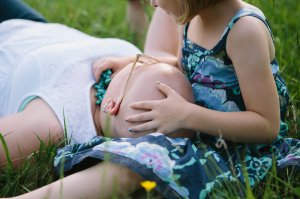



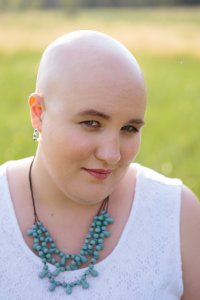
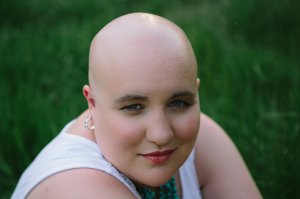
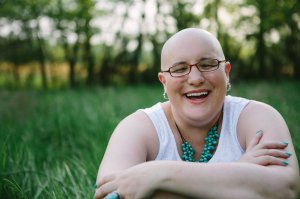
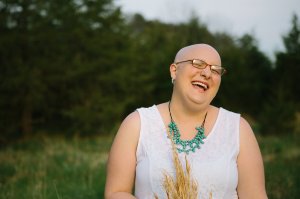
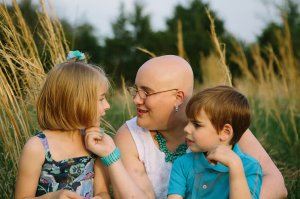
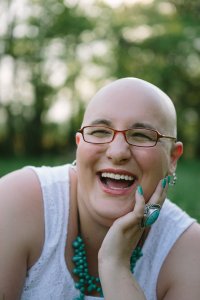
I definitely teared up when you wrote about your daughter’s reaction to you going out without a wig. I have moments like that from my own children. Teaching moments. Them teaching me. I love your testimony through this Rachael, thank you for sharing so candidly!